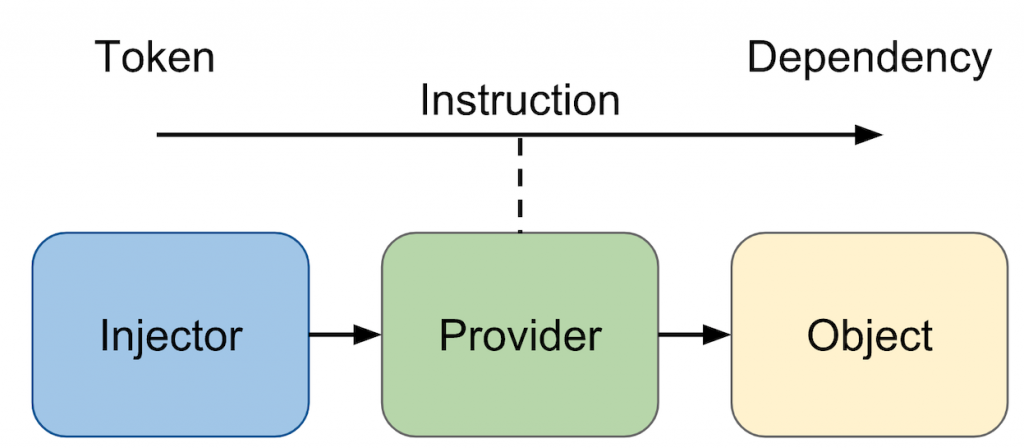在上一篇中提到了如何建立與使用一個 Service,也大概介紹了什麼是 Dependency Injection,在介紹使用 @Injectable() 裝飾 service 的 class 的時候提到了要在他的 metadata 中設定 providedIn,如果將它設定為 root 的話代表這個 service 在整個專案中都是可被使用的,但如果沒有設定這個 property,則要在 component 中注入這個 service 時需要在 @Component() 的 metadata 中設定 providers ,將要注入的 service 放進去,在上一章中的用法是 providers: [ProductService],這其實是一個縮寫,本篇就是要來詳細的介紹他,那我們就繼續往下看吧!

在上一章中提到了什麼是 Dependency injection 不過這邊再來複習一下,這有利於我們接下來要講的內容,簡單來說 Dependency injection 又稱 DI 它是一種設計模式和機制,他用於將某些部分與依賴相分離,以 Angular 的例子來說,他就是用於將複雜的邏輯與 Component 中負責處理畫面或事件的邏輯分離,而這些被分離出來的部分也可以給其他 Component 使用,使它變成可重複使用且可測試的一個部分。
當整個應用程式啟動時,會創建一個名為 injector 的東西,可以將它看成會檢查客戶訂單且滿足客戶要求的服務生,舉例來說他可以製作一些咖啡(實例化 CoffeeService)將它提供給客戶,而如果有其他的客戶想要喝茶,那麼這個聰明的服務生就會實例化 MintTeaService 和 CamomileTeaService 用於滿足不同客戶的需求。
然而要讓我們的服務生(injector)知道該出什麼餐點則需要客戶點單(component),他可以在 component 中的 constructor 中要求他要吃什麼(dependency)
constructor(private coffee: CoffeeService){};
coffee: CoffeeService 就是一個 Dependency injection tokens 它是一種 inject class 的快捷方式,現在我們的服務生從客戶那邊收集了所有的訂單( injector 向 component 收集需求 ),接著 服務生(injector) 會使用 CoffeeService 來找咖啡的標記,將客戶點的咖啡記在他的筆記本上。
記錄完客戶的點單後,接著就需要知道如何製作指定的咖啡,這時就需要配方(provider)了,這個配方是一個 object 他會定義如何獲取與 Dependency injection tokens 有關連的可注入依賴項,簡單來說他會告訴服務生(injector)該如何製作這杯咖啡( 將 service 實例化成一個 object 並將它注入給 component )
providers: [CoffeeService, BurgerService, PizzaService]
上面的例子來說服務生將知道如何做出咖啡、漢堡、Pizza 並提供給客戶,以程式的角度來看可以看成 injector 知道 CoffeeService 要使用 CoffeeService 作為模板將它實例化成一個 object 並注入給 component 讓他使用,這邊可能看不出來可以換另一種更詳細的表達方式
providers: [
{ provide: CoffeeService, useClass: CoffeeService },
{ provide: BurgerService, useClass: BurgerService },
{ provide: PizzaService, useClass: PizzaService }
]
這樣應該更可以了解,provide property 作爲 locating a dependency value 和 configuring the injector 的 Token,可以把它理解為他是一個 ID,以服務生的例子來說他就等於是客戶點的餐點名稱,以程式的觀點來看就等於他是 component 需要使用的 service name。
而第二個 property 是一個提供 provider 定義的一個 object,他會告訴 injector 該如何建立 dependency 的值,以上面的服務生例子來說他就是菜單,他會告訴服務生該怎麼製作客戶點的咖啡,而這個定義 provider 的 key 可以是 useClass 就像上面使用的,也可以是 useExisting、useValue 或 useFactory 他們每一個都提供了不同類型的 dependency,下面將仔細介紹他們的區別。

首先介紹的是 useClass ,不同的 class 可以提供給相同的 service,比如說
[{ provide: Logger, useClass: BetterLogger }]
上面的例子中代表 component 向 injector 説他需要使用 Logger,而 provider 向他提供了 BetterLogger 這個 class 讓 injector 將它實例化後注入給 component 使用。
如果使用 useClass 的這個 class 有自己的 dependencies,則要在父層 module 或 component 的 metadata 中的 providers 提供他自己於他的 dependencies,舉個例子
@Injectable()
export class EvenBetterLogger extends Logger {
constructor(private userService: UserService) { super(); }
log(message: string) {
const name = this.userService.user.name;
super.log(`Message to ${name}: ${message}`);
}
}
@Component({
providers: [UserService, { provide: Logger, useClass: EvenBetterLogger }]]
})
在 component 中使用 useClass 的 class 有自己的 dependencies (UserService),所以在 component 的 metadata 中也需要提供 UserService。
在我們使用 useClass 注入指定 class 內容時可能會遇到一個情況,一開始我們建立了兩個 service 分別是 oldService 與 newService,這兩個 service 一開始負責不同的服務但是到後來的增加跟刪除下,發現只要使用 newService 就好,當遇到這種情況可能有些人會到每個有使用到 oldService 的 component 或 module 去把它改掉,但其實 Angular 他提供了另一個方法那就是別名。
在提到這個方法之前先來釐清一下 useClass 的用法
providers: [{provide: Class1, useClass: Class1}]
當使用上面這個方法可以等價為將 Class1 注入到 component 或 module 中
providers: [{provide: Class1, useClass: Class3}]
而上面這個方法可以看成在 Component 或 module 中有一個名叫 Class1 的 Token 要用 Class3 創建並注入,那麼問題來了下面這樣該怎麼解釋?
providers: [
Class3,
{provide: Class1, useClass: Class3}
]
其實很簡單,你可以想像在這個 component 或 module 中有一個 Class3 的 Token 利用 Class3 創建並注入,還有第二個 Token 名叫 Class1 但是也是用 Class3 創建並注入,等於說這個 component 或 module 有兩個 class3 的實例。
有上面的概念後就可以來看 useExisting ,在一開始提到的我們希望 oldService 都替換成 newService 這時有人會下意識的覺得
providers: [
newService,
{provide: oldService, useClass: newService}
]
上面的這種改法可以看成在這個 component 或 module 中注入一個 newService 的實例並且在將一個名為 oldService 的 Token 也使用 newService 創建,等於說會有兩個 newService 這是我們不希望看見的,這時就可以用 useExisting 改寫
providers: [
newService,
{provide: oldService, useExisting: newService}
]
上面的寫法改成使用 useExisting 就可以避免建立兩個 newService 的情況了,可以想像是 newService 這個實例但是用了 oldService 這個別名。
除了使用 useClass 直接提供一個 class 之外,也可以使用 useValue 將一個 object 提供給 injector,舉例來說
export const silentLogger = {
logs: ['Silent logger says "Shhhhh!". Provided via "useValue"'],
log: () => {
console.log('You are log in');
}
}
@Component({
providers: [{ provide: Logger, useValue: silentLogger }]
})
上面的例子中可以看到,在別的地方建立一個 Object 並將它提供給 injector 讓他注入給 component 中讓 component 中可以使用到這個 Object 中的 property 與 method。
在上面可以看到我們在填入 property provide 的時候都是預定他是一個 service,那們可不可以填入某個 object 或一個 function 呢?答案是可以的,不過你得使用 InjectionToken 強制將你想填入的內容產生一個 token,舉個例子吧
import { Component, Inject, OnInit, InjectionToken } from '@angular/core';
export const APP_CONFIG = new InjectionToken<{ // (1)
apiEndpoint: string;
title: string;
}>('app.config');
@Component({
selector: 'app-root',
templateUrl: './app.component.html',
providers: [ // (2)
{
provide: APP_CONFIG,
useValue: {
apiEndpoint: 'api.heroes.com',
title: 'Dependency Injection',
},
},
],
})
export class AppComponent implements OnInit {
title!: string;
apiEndpoint!: string;
constructor(
@Inject(APP_CONFIG) config: { apiEndpoint: string; title: string } // (3)
) {
this.title = config.title;
this.apiEndpoint = config.apiEndpoint;
}
ngOnInit() {
console.log(this.title);
console.log(this.apiEndpoint);
}
}
@Inject() 裝飾器告知使用哪一個 token 注入
在介紹完 useValue 後可以看到就算是普通的 object 也可以使用 InjectionToken 強制產生一個 token,不過要這樣做的前提是要事先建立好要替代的 token 實體,但這種事先建立的情況在實際中不太常發生,比較多都是需要動態產生的,這時就可以使用 useFactory 把複雜的動態計算放在 factory 裏面,動態的建立需要的 token 實體,舉個例子
建立 service1 與 service2
ng generate service service1
ng generate service service1
在兩個 service 中添加一個 getName() method 但是回傳不同的字串
import { Injectable } from '@angular/core';
@Injectable({ providedIn: 'root' })
export class Service1Service {
constructor() { }
getName() {
return 'This is Service-1 method'
}
}
import { Injectable } from '@angular/core';
@Injectable({ providedIn: 'root' })
export class Service2Service {
constructor() { }
getName() {
return 'This is Service-2 method'
}
}
在 app.component.ts 中使用 useFactory
import { Component, InjectionToken, OnInit } from '@angular/core';
import { Service1Service } from './service1.service';
import { Service2Service } from './service2.service';
import { AppService } from './app.service';
export enum ServiceList { // (1)
SERVICE_1 = 0,
SERVICE_2 = 1
}
export const SelectService = new InjectionToken<number>('selectService'); // (2)
export const serviceFactory = (selectService: number) => { // (3)
if (selectService === ServiceList.SERVICE_1) {
return new Service1Service();
} else {
return new Service2Service();
}
}
@Component({
selector: 'app-root',
templateUrl: './app.component.html',
providers: [
{
provide: SelectService, // (4)
useValue: ServiceList.SERVICE_1
},
{
provide: AppService, // (5)
useFactory: serviceFactory,
deps: [SelectService]
}
],
})
export class AppComponent implements OnInit {
constructor(private appService: AppService) {} // (6)
ngOnInit() {
console.log('Useing Service: ', this.appService.getName());
}
}
Using an InjectionToken object 為 SelectService 這個 number 產生一個 TokenuseValue 將 SelectService Token 賦予 ServiceList.SERVICE_1 的值並將他創建出來注入給 app.componentuseFactory 將 Factory function 的結果提供給 AppService Token 並將他創建出來注入到 app.component 中這邊特別介紹一下 deps 這個 property,他是 injector 要解析的 Token list,然後他列表中的值會作為 useFactory 的參數傳入 factory function 中,這就是為什麼上面的例子中要先用 InjectionToken 產生一個 Token,這樣 injector 才能將 SelectService 解析並將其中的值,也就是使用 useValue 賦予的值傳遞近 factory function 裏面。
如果使用 useValue 設定值為 ServiceList.SERVICE_1 那們在 console 中會看到
app.component 中注入的 service 是 service1 的內容,而 useValue 設定值為 ServiceList.SERVICE_2 時
app.component 中注入的 service 變為 service2 的內容,這就是 useFactory 的概念,不過實際上 useFactory 用法會遠比上面的例子還要複雜得多,不過這邊介紹的是一個概念。
本章中介紹了什麼是 injector 與 provider 和他們之間的關係,用了一個客戶與服務生的例子,不過一樣實際上背後的原理比這個複雜得多,不過這邊就是介紹他的概念不會太過鑽研他背後的原理。
也介紹了 provider 可以透過使用 useClass、useValue、useFactory 或 useExisting 將 component 或 module 需要的 Token 利用不同的來源建立出來並注入回去,基本上大多都使用場景都是使用 useClass 跟 useValue,不過在面對比較複雜的專案時也會需要用到另外兩個,這樣才能使你的專案更加的靈活。
下一篇將會介紹 Angular 的 Router,他在 Angular 中也是佔有非常重要的地位,現代的網頁中沒有人只做一頁的,所以就需要 Router 來控制不同的 url 會進到那一個頁面,詳細的內容就留到明天再講解吧,那們一樣明天見囉!
